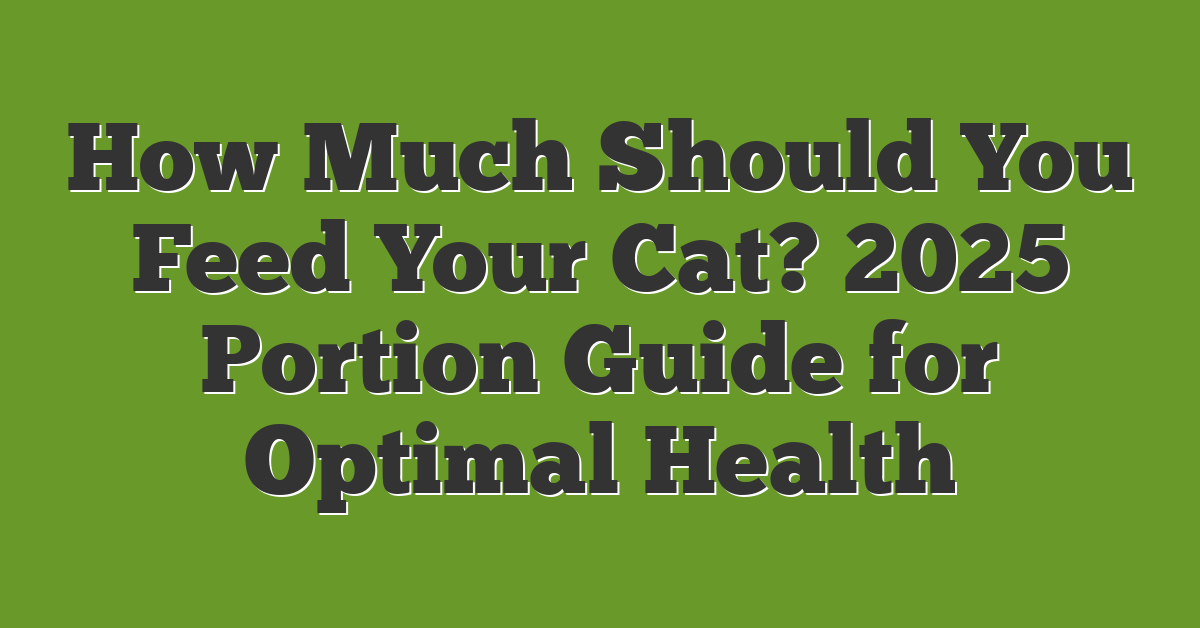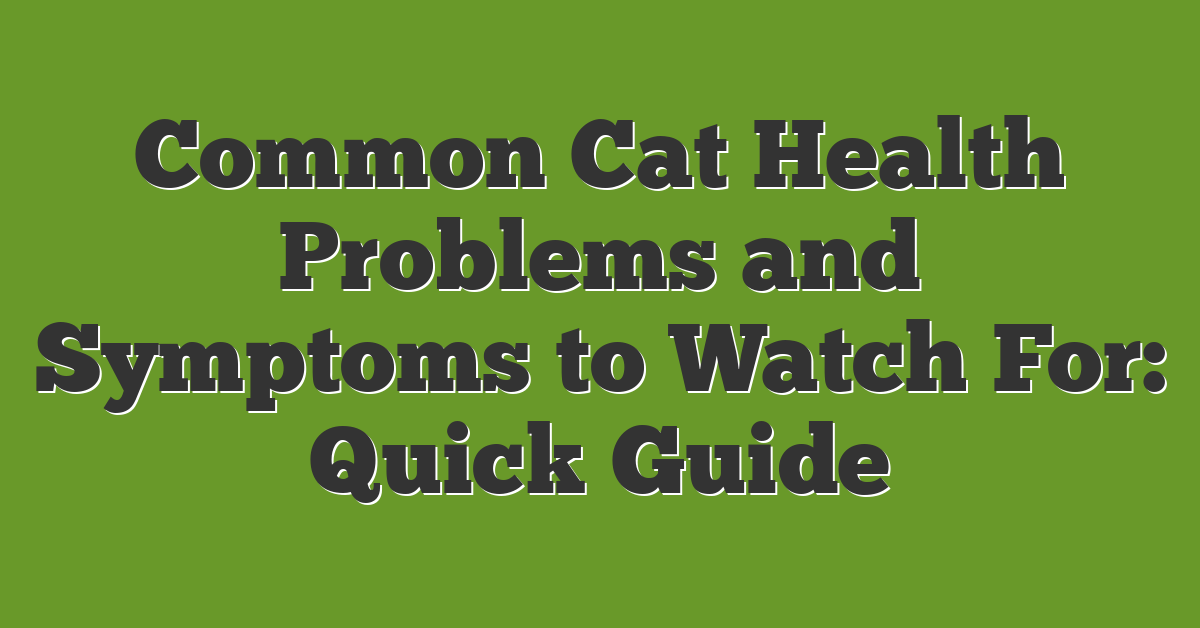Keeping your cat healthy starts with the right diet. You want to make sure you’re feeding your furry friend the perfect portions to keep them happy and energetic.

With so many factors to consider—from age and weight to activity level—it can be tricky to determine the right amount. Our 2025 Portion Guide breaks it all down for you, making it easy to provide the best nutrition for your cat.
Whether you’re a new cat parent or looking to adjust your pet’s diet, you’ll find practical tips to ensure your kitty thrives. Let’s dive in and discover how much you should feed your cat this year.
Understanding Your Cat’s Nutritional Needs
Meeting your cat’s nutritional needs ensures a healthy and happy life. Several factors influence how much to feed your cat.
Age and Life Stage
Kittens, adults, and senior cats have different dietary requirements. Kittens grow quickly and need more calories. Adults maintain their weight with a balanced diet. Senior cats may need fewer calories but more joint support.
Weight and Activity Level
Active cats burn more calories and may require larger portions. Overweight cats need controlled portions to lose weight safely. Regular exercise helps manage your cat’s weight and overall health.
Types of Cat Food
Choose the right type of food for your cat’s health.
Dry Food
Dry food keeps longer and is easy to store. It provides crunchiness, which helps clean your cat’s teeth. If you want convenience, dry food fits well. Many dry foods contain balanced nutrients your cat requires.
Wet Food
Wet food offers more moisture, aiding hydration. It tastes rich, which many cats love. If your cat prefers soft food, choose wet options. Wet food helps support urinary health by increasing water intake.
Calculating Appropriate Portion Sizes
Determining your cat’s portion sizes keeps them healthy and active. Use these guidelines to calculate the right amount to feed your cat.
Daily Caloric Requirements
Estimate your cat’s daily calories based on weight and activity level. Refer to the table below:
| Weight (lbs) | Sedentary (cal/day) | Active (cal/day) |
|---|---|---|
| 5 | 180 | 200 |
| 10 | 200 | 240 |
| 15 | 220 | 280 |
| 20 | 240 | 320 |
Adjust portions if your cat is more or less active.
Adjusting for Health Conditions
Modify your cat’s diet based on their health needs:
- Obesity: Reduce calories by 20%. Provide low-fat food options.
- Diabetes: Offer high-protein, low-carb meals. Split portions into smaller, frequent feeds.
- Kidney Disease: Choose diets low in phosphorus and protein.
- Hyperthyroidism: Select foods with controlled iodine levels.
Monitor your cat’s weight and consult your vet for personalized advice.
Feeding Schedules and Best Practices
Establishing a consistent feeding schedule keeps your cat healthy and happy. Here are some best practices to follow:
Number of Meals Per Day
Most cats do well with two meals daily:
- Morning: Serve half of the daily portion.
- Evening: Serve the remaining half.
Kittens under six months may need three to four meals a day to support their growth.
Scheduled Feeding vs. Free Feeding
Scheduled Feeding:
- Offers controlled portion sizes.
- Helps monitor your cat’s appetite and weight.
- Reduces the risk of overeating.
Free Feeding:
- Provides constant access to food.
- Suitable for cats that regulate their intake.
- Not ideal for overweight cats or those with specific dietary needs.
Consistent Feeding Times
Feed your cat at the same times each day. Consistency helps regulate their digestion and reduces anxiety around meal times.
Portion Control
Use the 2025 Portion Guide to determine the right amount:
- Kittens: Higher calorie needs for growth.
- Adults: Balanced diet to maintain weight.
- Seniors: Fewer calories with joint support.
Refer to the following table for daily caloric needs:
| Weight (lbs) | Sedentary (cal) | Active (cal) |
|---|---|---|
| 5 | 180 | 200 |
| 10 | 250 | 280 |
| 15 | 320 | 360 |
Monitoring and Adjusting
Regularly check your cat’s weight and body condition. If your cat is gaining or losing weight, adjust the portion sizes accordingly. Consult your veterinarian for personalized advice.
Best Practices
- Separate Feeding Area: Provide a quiet space for your cat to eat without disturbances.
- Fresh Water: Always have clean water available.
- Avoid Human Food: Stick to cat-specific diets to prevent nutritional imbalances.
- Interactive Feeding: Use puzzle feeders to stimulate your cat mentally and slow down eating.
By following these feeding schedules and best practices, you ensure your cat receives the nutrition they need for a healthy and active life.
Common Feeding Mistakes to Avoid
Avoid overfeeding your cat by sticking to the recommended portions. Obesity can lead to health issues like diabetes and arthritis. Use the 2025 Portion Guide to measure each meal accurately.
Feeding only dry food might miss important nutrients. Incorporate wet food to ensure your cat stays hydrated and receives a balanced diet. Combining both types can offer the best of both worlds.
Free feeding allows constant access to food, but it can cause overeating. Instead, schedule regular meals to control portions and monitor your cat’s appetite. This approach helps maintain a healthy weight.
Ignoring your cat’s weight changes can be harmful. Regularly weigh your cat and adjust portions as needed. Consult your veterinarian if you notice significant weight gain or loss.
Providing human food can disrupt your cat’s diet. Foods like chocolate, onions, and garlic are toxic to cats. Stick to cat-approved treats to keep your pet safe and healthy.
Skipping feeding times can lead to anxiety and irregular eating habits. Maintain a consistent schedule to support your cat’s digestion and overall well-being. Predictable meal times create a stable routine for your feline friend.
Using inappropriate bowls can affect your cat’s eating behavior. Choose shallow, wide bowls to prevent whisker fatigue and make eating comfortable. Proper feeding dishes enhance your cat’s mealtime experience.
Failing to provide fresh water can lead to dehydration. Always have clean water available alongside meals. Hydration is essential for your cat’s kidney health and overall vitality.
By avoiding these common mistakes, you ensure your cat enjoys a balanced diet and maintains optimal health.
Conclusion
Providing the right portions is key to your cat’s well-being. With the 2025 Portion Guide you can easily tailor their meals to fit their unique needs. Keep an eye on their weight and activity to make sure they stay healthy and happy. Regular check-ins and adjustments help maintain their optimal diet. Balancing their food with plenty of fresh water and a bit of exercise ensures your furry friend thrives. You’re on the right track to giving your cat a vibrant and joyful life
















